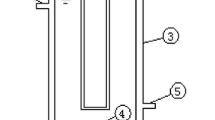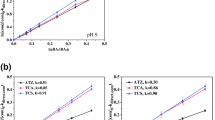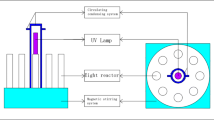Abstract
This study compared the behaviors of two classic advanced oxidation processes (AOPs), hydroxyl radical-based AOPs (•OH-based AOPs) and sulfate radical-based AOPs (SO4 •−-based AOPs), represented by UV/ hydrogen peroxide (H2O2) and UV/peroxydisulfate (PDS) systems, respectively, to degrade humic acid (HA) in the presence of halide ions (Cl− and Br−). The effects of different operational parameters, such as oxidant dosages, halide ions concentration, and pH on HA degradation were investigated in UV/H2O2/Cl−, UV/PDS/Cl−, UV/H2O2/Br−, and UV/PDS/Br− processes. It was found that the oxidation capacity of H2O2 and PDS to HA degradation in the presence of halides was nearly in the same order. High dosage of peroxides would lead to an increase in HA removal while excess dosage would slightly inhibit the efficiency. Both Cl− and Br− would have depressing impact on the two AOPs, but the inhibiting effect of Br− was more obvious than that of Cl−, even the concentration of Cl− was far above that of Br−. The increasing pH would have an adverse effect on HA decomposition in UV/H2O2 system, whereas there was no significant impact of pH in UV/PDS process. Furthermore, infrared spectrometer was used to provide the information of degraded HA in UV/H2O2/Cl−, UV/PDS/Cl−, UV/H2O2/Br−, and UV/PDS/Br− processes, and halogenated byproducts were identified in using GC-MS analysis in the four processes. The present research might have significant technical implications on water treatment using advanced oxidation technologies.




Similar content being viewed by others
References
Al-Rasheed R, Cardin DJ (2003) Photocatalytic degradation of humic acid in saline waters Part 2. Effects of various photocatalytic materials. Appl Catal A Gen 246:39–48
Anipsitakis GP, Dionysiou DD (2004) Radical generation by the interaction of transition metals with common oxidants. Environ Sci Technol 38:3705–3712
Crowder GA, Smith C (1979) Vibrational analysis of 1,3-dichlorobutane and 1,3-dibromobutane. J Mol Struct 51:157–162
Fukushima M, Tatsumi K (2001) Degradation characteristic of humic acid during photo-Fenton processes. Environ Sci Technol 35:3683–3690
Furman OS, Tell AL, Watts RJ (2010) Mechanism of base activation of persulfate. Environ Sci Technol 44:6423–6428
Grebel JE, Pignatello JJ, Mitch WA (2010) Effect of halide ions and carbonates on organic contaminant degradation by hydroxyl radical-based advanced oxidation processes in saline waters. Environ Sci Technol 44:6822–6828
Gu X, Lu S, Qiu Z, Sui Q, Miao Z, Lin K, Liu Y, Luo Q (2012) Comparison of photodegradation performance of 1,1,1-trichloroethane in aqueous solution with the addition of H2O2 or S2O8 2− oxidants. Ind Eng Chem Res 51:7196–7204
Guo N, Jiang T, Wei SQ, Yan JL, Liang J, Lu S, Gao J (2014a) Effects of light irradiation on phosphorous releases from typical submerged soils of water-level fluctuation zones of three gorges reservoirs areas. Environ Sci 35:4244–4552
Guo Y, Zhou J, Lou X, Liu R, Xiao D, Fang C, Wang Z, Liu J (2014b) Enhanced degradation of tetrabromobisphenol A in water by a UV/base/persulfate system: kinetics and intermediates. Chem Eng J 254:538–544
Hirakawa T, Nosaka Y (2002) Properties of O2 •− and •OH formed in TiO2 aqueous suspensions by photocatalytic reaction and the influence of H2O2 and some ions. Langmuir 18:3247–3254
Imai D, Dabwan AHA, Kaneco S, Katsumata H, Suzuki T, Kato T, Ohta K (2009) Degradation of marine humic acids by ozone-initiated radical reactions. Chem Eng J 148:336–341
Jacangelo JG, DeMarco J, Owen DM, Randtke SJ (1995) Selected processes for removing NOM. J Am Water Works Ass 87:64–77
Kim HC, Yu MJ (2005) Characterization of natural organic matter in conventional water treatment processes for selection of treatment processes focused on DBPs control. Water Res 39:4779–4789
Lebedev AT, Shaydullina GM, Sinikova NA, Harchevnikova NV (2004) GC-MS comparison of the behavior of chlorine and sodium hypochlorite towards organic compounds dissolved in water. Water Res 38:3713–3718
Li A, Zhao X, Liu H, Qu J (2011) Characteristic transformation of humic acid during photoelectrocatalysis process and its subsequent disinfection byproduct formation potential. Water Res 45:6131–6140
Liang C, Wang Z, Mohanty N (2006) Influences of carbonate and chloride ions on persulfate oxidation of trichloroethylene at 20 °C. Sci Total Environ 370:271–277
Liang CJ, Wang ZS, Bruell CJ (2007) Influence of pH on persulfate oxidation of TCE at ambient temperatures. Chemosphere 66:106–113
Liao CH, Lu MC, Su SH (2001) Role of cupric ions in the H2O2/UV oxidation of humic acids. Chemosphere 44:913–919
Lin C, Liu S, Hao OJ (2001) Effect of functional groups of humic substances on UF performance. Water Res 35:2395–2402
Liu S, Lim M, Fabris R, Chow C, Drikas M, Amal R (2010) Comparison of photocatalytic degradation of natural organic matter in two Australian surface waters using multiple analytical techniques. Org Geochem 41:124–129
Liu XW, Zhang TQ, Zhou YC, Fang L, Shao Y (2013) Degradation of atenolol by UV/peroxymonosulfate: kinetics, effect of operational parameters and mechanism. Chemosphere 93:2717–2724
Neta P, Huie RE, Ross AB (1988) Rate constants for reactions of inorganic radicals in aqueous solution. J Phys Chem Ref Data 17:1027–1284
Nienow AM, Bezares-Cruz JC, Poyer IC, Hua I, Jafvert CT (2008) Hydrogen peroxide-assisted UV photodegradation of Lindane. Chemosphere 72:1700–1705
Pignatello J, Oliveros E (2006) Advanced oxidation processes for organic contaminant destruction based on the Fenton reaction and related chemistry. Crit Rev Environ Sci Technol 36:1–84
Selcuk H, Bekbolet M (2008) Photocatalytic and photoelectrocatalytic humic acid removal and selectivity of TiO2 coated photoanode. Chemosphere 73:854–858
Su SN, Guo WL, Yi CL, Leng YQ, Ma ZM (2012) Degradation of amoxicillin in aqueous solution using sulphate radicals under ultrasound irradiation. Ultrason Sonochem 19:469–474
Uyguner CS, Bekbolet M (2005) Evaluation of humic acid photocatalytic degradation by UV–Vis and fluorescence spectroscopy. Catal Today 101:267–274
Wang GS, Liao CH, Wu FJ (2011a) Photodegradation of humic acids in the presence of hydrogen peroxide. Chemosphere 42:379–387
Wang Z, Yuan R, Guo Y, Xu L, Liu J (2011b) Effects of chloride ions on bleaching of azo dyes by Co2+/oxone regent: kinetic analysis. J Hazard Mater 190:1083–1087
Wang Y, Roux JL, Zhang T, Croue JP (2014) Formation of brominated disinfection byproducts from natural organic matter isolates and model compounds in a sulfate radical-based oxidation process. Environ Sci Technol 48:14534–14542
Wang S, Zhou N, Wu S, Zhang Q, Yang Z (2015) Modeling the oxidation kinetics of sono-activated persulfate’s process on the degradation of humic acid. Ultrason Sonochem 23:128–134
Wu Y, Zhou S, Qin F, Zheng K, Ye X (2010) Modeling the oxidation kinetics of Fenton’s process on the degradation of humic acid. J Hazard Mater 179:533–539
Xue S, Zhao Q, Wei L, Ren N (2009) Behavior and characteristics of dissolved organic matter during column studies of soil aquifer treatment. Water Res 43:499–507
Yang SY, Wang P, Yang X, Shan L, Zhang WY, Shao XT, Niu R (2010) Degradation efficiencies of azo dye Acid Orange 7 by the interaction of heat, UV and anions with common oxidants: persulfate, peroxymonosulfate and hydrogen peroxide. J Hazard Mater 179:552–558
Yuan R, Ramjaum SN, Wang Z, Liu J (2012a) Concentration profiles of chlorine radicals and their significances in OH-induced dye degradation: kinetic modeling and reaction pathways. Chem Eng J 209:38–45
Yuan R, Ramjaum SN, Wang Z, Liu J (2012b) Effects of chloride ion on degradation of acid orange 7 by sulfate radical-based advanced oxidation process: implications for formation of chlorinated aromatic compounds. J Hazard Mater 196:173–179
Yuan R, Wang Z, Hu Y, Wang B, Gao S (2014) Probing the radical chemistry in UV/persulfate-based saline wastewater treatment: kinetics modeling and byproducts identification. Chemosphere 109:106–112
Acknowledgments
This work was financially supported by National Natural Science Foundation of China (NSFC) (No. 41273108 and 21377023), Fundamental Research funds for Central Universities (2232013A3-08) and DHU Distinguished Young Professor Program (15D211303) and Shanghai Pujiang Program. Dr. X. Lou and Y. Guo thank Chinese Universities Scientific Fund (Nos. 13D311303 and 14D311304) for the financial support. Dr. Y. Guo also appreciates the Shanghai Sailing Program (15YF1404300), Shanghai University Youth Teacher Funding Program (ZZZZEGD15011), and Scientific Research Fund Project of Shanghai Second Polytechnic University (EGD15XQD02).
Author information
Authors and Affiliations
Corresponding authors
Additional information
Responsible editor: Philippe Garrigues
Electronic supplementary material
Below is the link to the electronic supplementary material.
ESM 1
(DOCX 3413 kb)
Rights and permissions
About this article
Cite this article
Lou, X., Xiao, D., Fang, C. et al. Comparison of UV/hydrogen peroxide and UV/peroxydisulfate processes for the degradation of humic acid in the presence of halide ions. Environ Sci Pollut Res 23, 4778–4785 (2016). https://doi.org/10.1007/s11356-015-5232-x
Received:
Accepted:
Published:
Issue Date:
DOI: https://doi.org/10.1007/s11356-015-5232-x




